Join me on a journey to discover the fascinating world of the durian tree. As a tropical fruit tree native to Southeast Asia and southern China, the durian tree is renowned for its exotic fruits and unique characteristics. In this article, we will delve into the different varieties of durian trees, learn how to care for them, and explore the secrets of successful cultivation.
Key Takeaways:
- There are various durian tree varieties, each with its own distinct characteristics and flavors.
- Taking care of a durian tree involves proper watering, fertilization, and protection from pests and diseases.
- Pruning is essential for maintaining the health and productivity of a durian tree.
- Durian trees require cross-pollination for fruit production and benefit from a diverse range of pollinators.
- Creating an ideal environment, including proper sunlight, well-drained soil, and regular fertilization, is crucial for the growth of durian trees.
Understanding the Durian Tree’s Height and Growth
The durian tree is known for its impressive height, with some varieties reaching up to 150 feet tall. However, the actual height of a durian tree can vary depending on factors such as the specific variety and the growing conditions it experiences.
Propagation of durian trees can be done through two main methods: seeds or grafting. Growing durian trees from seeds is a more accessible option for home gardeners. It involves planting the seeds in a suitable potting mix and providing the right conditions for germination. On the other hand, grafting requires more expertise and involves joining a scion from a desired variety onto a rootstock. Both methods have their advantages and challenges, and the choice depends on individual preferences and resources.
Understanding the Durian Tree’s Height
Different durian tree varieties can vary in their maximum height, leading to a range of tree sizes. Some varieties may only reach around 50 feet tall, while others can grow as high as 150 feet. The height of the tree is influenced by various factors such as genetics, growing conditions, and pruning practices.
Propagation Methods for Durian Trees
Durian trees can be propagated through seeds or grafting. Growing durian trees from seeds is relatively simple and accessible for home gardeners. It involves planting the seeds in a quality potting mix, providing adequate moisture and warmth, and waiting for the seeds to germinate and grow into young seedlings. Grafting, on the other hand, requires more skill and expertise. It involves joining a scion (a small branch or bud) from a desirable durian variety onto a rootstock of a different durian tree. This method allows for the creation of clones and ensures that the newly propagated tree will have the same characteristics as the desired variety.
| Durian Tree Variety | Maximum Height (in feet) |
|---|---|
| Musang King | 120 |
| D24 | 130 |
| Monthong | 130 |
| Chanee | 150 |
As seen in the table above, different durian tree varieties can have varying maximum heights. Musang King, D24, and Monthong varieties typically grow up to 120-130 feet tall, while the Chanee variety can reach a maximum height of 150 feet.
Understanding the height and growth patterns of durian trees is essential for proper cultivation and care. Whether you’re a home gardener or an enthusiast, knowing these factors can help you create the ideal environment for the durian tree to thrive and produce its delicious fruits.
The Art of Pruning Durian Trees
Pruning is a crucial aspect of caring for durian trees to ensure their health and productivity. It involves removing diseased or dead branches, promoting better airflow, and encouraging new growth. When done correctly, pruning helps maintain the tree’s shape, control its size, and improve fruit production.
One important consideration when pruning durian trees is timing. It is generally recommended to prune during the dry season when the tree is dormant. This minimizes the risk of infections and allows the tree to heal faster. It’s crucial to avoid heavy pruning during the fruiting season, as it can affect the tree’s energy reserves and reduce fruit quality.
When pruning durian trees, it’s essential to follow proper techniques. Make clean cuts just above a bud or lateral branch, leaving the branch collar intact. This promotes faster healing and reduces the risk of infections. Disinfecting pruning tools between cuts is also crucial to prevent the spread of diseases.
Benefits of Pruning Durian Trees:
- Promotes better airflow and reduces the risk of diseases
- Removes dead or diseased branches, ensuring the overall health of the tree
- Encourages new growth and improves fruit production
- Maintains the desired shape and size of the tree
Common Mistakes to Avoid:
- Pruning during the fruiting season, which can negatively impact fruit quality
- Leaving stubs or making improper cuts, which can lead to infections
- Over-pruning, which can weaken the tree and reduce fruit production
By mastering the art of pruning durian trees, gardeners can maintain healthy, productive trees that bear high-quality fruits. Regular pruning, done with proper timing and techniques, is key to ensuring the longevity and vitality of these remarkable tropical trees.
| Benefits of Pruning Durian Trees | Common Mistakes to Avoid |
|---|---|
| Promotes better airflow and reduces the risk of diseases | Pruning during the fruiting season, which can negatively impact fruit quality |
| Removes dead or diseased branches, ensuring the overall health of the tree | Leaving stubs or making improper cuts, which can lead to infections |
| Encourages new growth and improves fruit production | Over-pruning, which can weaken the tree and reduce fruit production |
| Maintains the desired shape and size of the tree |
Ensuring Successful Durian Tree Pollination
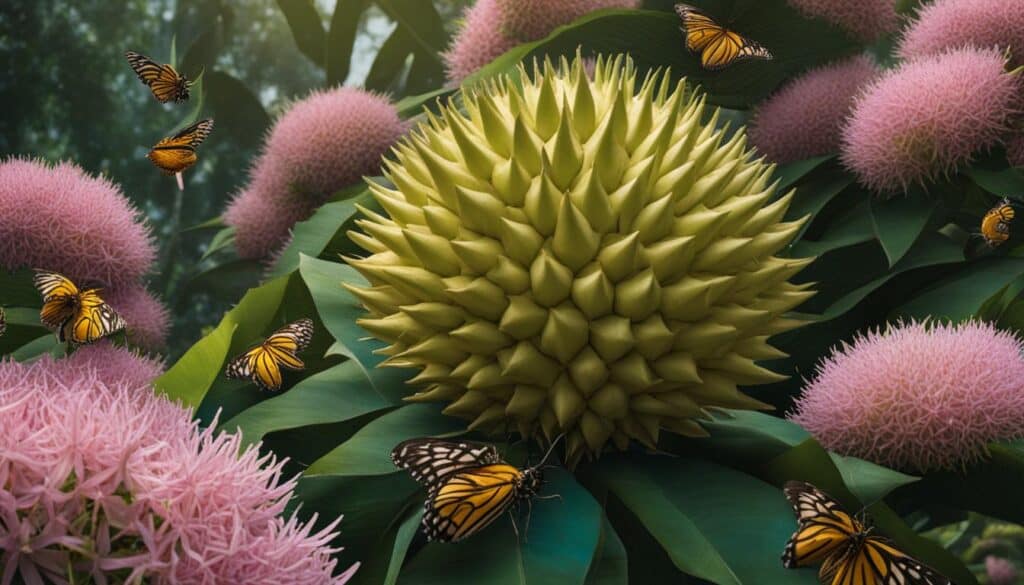
Pollination is a crucial step in the cultivation of durian trees. These tropical trees rely on cross-pollination to produce their delicious fruits. Durian tree flowers are naturally pollinated by bats and insects, such as beetles and bees. To ensure successful pollination, it is important to create an environment that attracts a diverse range of pollinators to the durian tree plantation.
One way to encourage pollinators is by planting flowering plants and native vegetation near the durian trees. These plants provide nectar and serve as feeding sources, attracting bats and insects. Additionally, maintaining a healthy ecosystem by avoiding excessive pesticide use can help preserve natural pollinators and foster a balanced environment for durian tree pollination.
Some durian tree varieties are self-fruitful, meaning they can produce fruits without cross-pollination. However, for those varieties that require cross-pollination, it is crucial to have compatible varieties nearby for successful fruit set. Planting different varieties with overlapping flowering periods can increase the chances of cross-pollination, resulting in abundant fruit production.
Summary:
- Durian trees require cross-pollination for fruit production.
- Attracting a diverse range of pollinators, such as bats and insects, is essential for successful pollination.
- Planting flowering plants and native vegetation near the durian trees can attract pollinators.
- Maintaining a healthy ecosystem with minimal pesticide use is crucial for preserving natural pollinators.
- Some durian tree varieties are self-fruitful, while others require cross-pollination with compatible varieties for fruit set.
| Pollination Tips | Benefits | Actions |
|---|---|---|
| Plant flowering plants | Attract pollinators | Choose plants that provide nectar and serve as feeding sources for bats and insects. |
| Maintain a healthy ecosystem | Preserve natural pollinators | Minimize pesticide use and create a balanced environment. |
| Plant compatible varieties | Increase fruit production | Ensure there are compatible durian tree varieties nearby for cross-pollination. |
Cultivating Durian Trees: Tips and Tricks
Cultivating durian trees can be a fulfilling journey that allows you to experience the unique flavors and characteristics of this tropical fruit. To ensure successful durian tree cultivation, there are several key tips and tricks to keep in mind.
Leverage the Tropical Climate
Durian trees thrive in tropical climates with high humidity and warm temperatures. When selecting a location for your durian tree, choose an area that receives ample sunlight and has well-drained soil. This will provide the optimal conditions for growth and fruit production. Additionally, consider planting durian trees in a sheltered location to protect them from strong winds that can damage the branches and fruits.
Proper Care is Essential
To ensure the health and vitality of your durian trees, regular care is crucial. Maintain a consistent watering schedule, providing enough water to keep the soil moist but not waterlogged. Durian trees also benefit from regular fertilization with a balanced fertilizer to promote healthy growth. Implementing a pest control strategy is essential to protect your durian trees from common pests and diseases. Regularly monitor your trees for any signs of infestation or disease and take appropriate action promptly.
Promote Good Airflow
Proper airflow is important for the overall health of your durian trees. Adequate spacing between trees allows for better circulation of air and reduces the risk of diseases. Pruning your durian trees to remove dead or crowded branches can also help improve airflow and promote new growth. However, avoid heavy pruning during the fruiting season to prevent affecting future fruit production.
Table: Durian Tree Care Checklist
| Aspect | Actions |
|---|---|
| Sunlight | Plant durian trees in a location that receives full sunlight. |
| Watering | Maintain a consistent watering schedule, keeping the soil moist but not waterlogged. |
| Fertilization | Regularly fertilize durian trees with a balanced fertilizer to provide essential nutrients. |
| Pest Control | Implement a pest control strategy to protect durian trees from pests and diseases. |
| Pruning | Prune durian trees during the dry season to remove dead or crowded branches and promote new growth. |
“It’s important to remember that durian trees require patience and dedication. With proper care and attention, you’ll be rewarded with delicious and unique fruits that are worth the wait!”
Unveiling Fascinating Durian Tree Facts
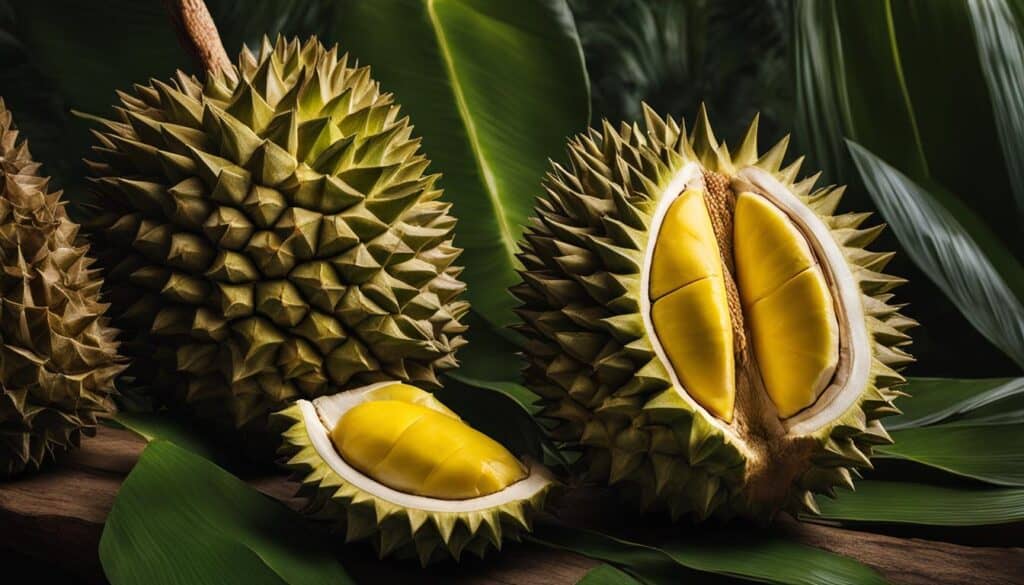
When it comes to fascinating facts about durian trees, there is no shortage of intriguing information to explore. From the distinctive features of the durian fruit to the cultural significance of the tree, here are some captivating facts that make the durian tree a truly remarkable plant.
First and foremost, the durian fruit itself is known for its strong odor, which has earned it the nickname “the king of fruits.” This pungent aroma may be off-putting to some, but it is beloved by many who consider it a unique and delightful scent.
“The durian is like a strange, exotic beauty that is not easily forgotten. Its aroma is both alluring and divisive, captivating the senses and stirring curiosity.”
In addition to its distinct smell, the durian fruit also stands out with its spiky husk and creamy, custard-like flesh. The texture of durian flesh is often described as smooth and buttery, and its flavor is a delightful combination of sweet and savory notes. Each durian tree variety offers its own unique flavor profile, making it an adventurous culinary experience for those who dare to try.
Beyond its fruit, the durian tree holds significance in Southeast Asian countries where it is grown. The tree’s timber is highly prized for its quality and is used in various applications such as furniture and construction. This valuable resource has been utilized for centuries and continues to be a vital part of the local economy.
Key Facts about Durian Trees:
- Durian fruit is renowned for its strong odor, earning it the nickname “the king of fruits”.
- The fruit has a spiky husk and creamy, custard-like flesh with a unique and delicious flavor.
- Durian trees provide valuable timber used in furniture and construction.
| Fact | Description |
|---|---|
| Distinct Smell | The durian fruit is known for its strong and divisive odor. |
| Unique Flavor | The creamy flesh of the durian fruit offers a delightful blend of sweet and savory flavors. |
| Valuable Timber | The durian tree’s timber is highly prized for its quality and is used in various applications. |
Exploring Different Durian Tree Varieties
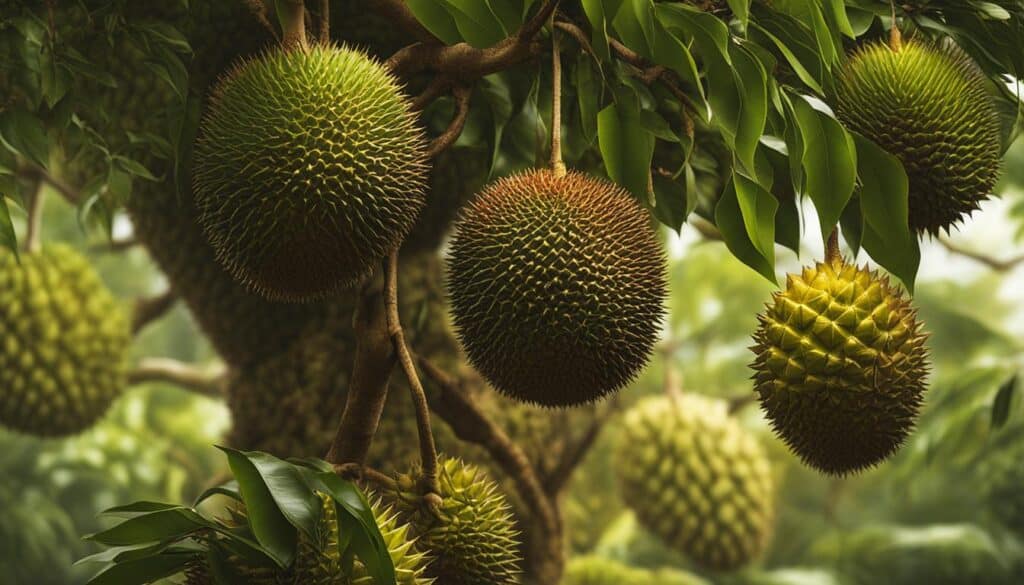
When it comes to durian trees, there is a wide range of varieties to explore, each with its own unique characteristics and flavors. Let’s take a closer look at some popular durian tree cultivars:
Musang King
Musang King is known for its creamy and bittersweet flesh, making it a favorite among durian enthusiasts. This variety is prized for its large and elongated fruits, which have a distinctive yellowish flesh and a strong aroma.
D24
D24 is another popular durian variety that is adored for its rich and buttery texture. The fruits of D24 are medium-sized with a pale yellow flesh and a sweet, slightly bitter taste. This cultivar is highly sought after for its intense flavor profile.
Monthong
Also known as the “Golden Pillow,” Monthong durian is favored for its large, round fruits and smooth, luscious flesh. This variety is renowned for its sweet taste and mild aroma, making it a crowd-pleaser.
Chanee
Chanee durian is famous for its vibrant yellow flesh and a delightful combination of sweetness and bitterness. The fruits of this variety are medium to large in size and have a rich, creamy texture that melts in your mouth.
These are just a few examples of the many durian tree varieties available. Each variety offers a unique flavor experience, allowing durian enthusiasts to discover their personal favorites. Whether you prefer the bittersweetness of Musang King, the buttery richness of D24, the sweetness of Monthong, or the delightful balance of sweetness and bitterness in Chanee, the world of durian tree varieties is sure to satisfy your taste buds.
| Durian Variety | Flavor | Fruit Size | Color | Aroma |
|---|---|---|---|---|
| Musang King | Bittersweet | Large | Yellowish | Strong |
| D24 | Rich and buttery | Medium | Pale yellow | Slight bitterness |
| Monthong | Sweet | Large | Golden | Mild |
| Chanee | Sweet with a hint of bitterness | Medium to large | Yellow | Delicate |
Whether you’re a durian connoisseur or a curious food lover, exploring the different durian tree varieties is an exciting journey into the world of exotic fruits. Each variety offers its own unique flavor profile and characteristics, ensuring a diverse and delightful durian experience. So why not embark on a durian adventure and discover the variety that tantalizes your taste buds the most?
Creating an Ideal Environment for Durian Tree Growth
To ensure optimal growth and fruit production, durian trees require specific environmental conditions. Here are some key factors to consider when creating an ideal environment for your durian trees.
1. Sunlight
Durian trees thrive in full sunlight, so it’s important to plant them in a location where they can receive at least 6-8 hours of direct sunlight each day. However, they can also tolerate partial shade, so if you live in an area with intense heat, providing some shade during the hottest part of the day may be beneficial.
2. Soil
The soil should be well-drained and rich in organic matter. Durian trees prefer slightly acidic soil with a pH level between 5.5 and 6.5. If your soil is clay or compacted, amending it with organic matter such as compost or aged manure can improve drainage and fertility.
3. Watering
Adequate watering is crucial, especially during dry periods. Durian trees require regular watering to keep the soil consistently moist but not waterlogged. Avoid overwatering, as it can lead to root rot. To determine when to water, check the moisture level of the soil by sticking your finger about an inch deep into the soil. If it feels dry, it’s time to water.
4. Fertilization
Durian trees benefit from regular fertilization to ensure they receive the necessary nutrients for growth and fruit production. Use a balanced fertilizer with a ratio of 10-10-10 or 14-14-14, and apply it according to the manufacturer’s instructions. It’s best to divide the fertilizer into multiple applications throughout the growing season, starting in early spring.
5. Pest and Disease Control
Implementing pest and disease control measures is crucial to protect your durian trees from common issues. Regularly inspect the trees for signs of pests, such as aphids or mites, and treat them with suitable insecticides if necessary. Additionally, monitor the trees for any signs of diseases, such as fungal infections or leaf spot, and take appropriate actions, such as pruning affected branches or applying fungicides.
By creating an ideal environment for your durian trees, you can promote healthy growth and maximize fruit production. Remember to provide them with adequate sunlight, well-drained soil, proper watering, and regular fertilization. Implementing pest and disease control measures will help protect your trees and ensure they thrive in your garden.
Tips for Successful Durian Tree Propagation
When it comes to propagating durian trees, there are two popular methods to choose from: seed propagation and grafting. Both methods have their own advantages and challenges, so it’s important to consider your preferences and available resources before deciding which approach to take.
Seed Propagation: Growing durian trees from seeds is a simple and accessible method, especially for home gardeners. To start, collect fresh durian seeds from a ripe fruit and remove the outer husk. Fill a pot with a suitable potting mix and plant the seeds about an inch deep. Keep the soil moist and place the pot in a warm and sunny location. Germination can take anywhere from a few weeks to a couple of months. Once the seedlings have grown a few inches tall, they can be transplanted into larger pots or directly into the ground.
Grafting: Grafting is a more advanced technique that involves joining a scion from a desired durian tree variety onto a rootstock. This method allows you to preserve the characteristics of a specific durian cultivar and ensure consistent fruit quality. Grafting requires expertise and careful handling of the plant materials. It’s best to seek guidance from experienced grafters or horticulturists if you’re new to this technique.
Comparing Seed Propagation and Grafting
| Seed Propagation | Grafting | |
|---|---|---|
| Level of Difficulty | Easy | Advanced |
| Genetic Variation | High | Preserves desired characteristics |
| Time to Fruit Production | Longer (5-7 years) | Shorter (2-3 years) |
| Plant Vigor | Varies | Depends on rootstock |
| Availability of Plant Materials | Easy to obtain | Requires access to scions and rootstocks |
Both seed propagation and grafting have their own set of pros and cons. Seed propagation offers genetic diversity and simplicity, but it takes longer for the tree to bear fruits. On the other hand, grafting allows you to propagate specific cultivars and achieve quicker fruit production, but it requires more knowledge and access to suitable plant materials.
Whether you choose seed propagation or grafting, it’s important to provide the necessary care and attention to the young durian trees. This includes regular watering, fertilization, and protection from pests and diseases. With patience and proper care, you can successfully propagate durian trees and enjoy the delicious fruits they bear.
Maintaining the Health and Longevity of Durian Trees
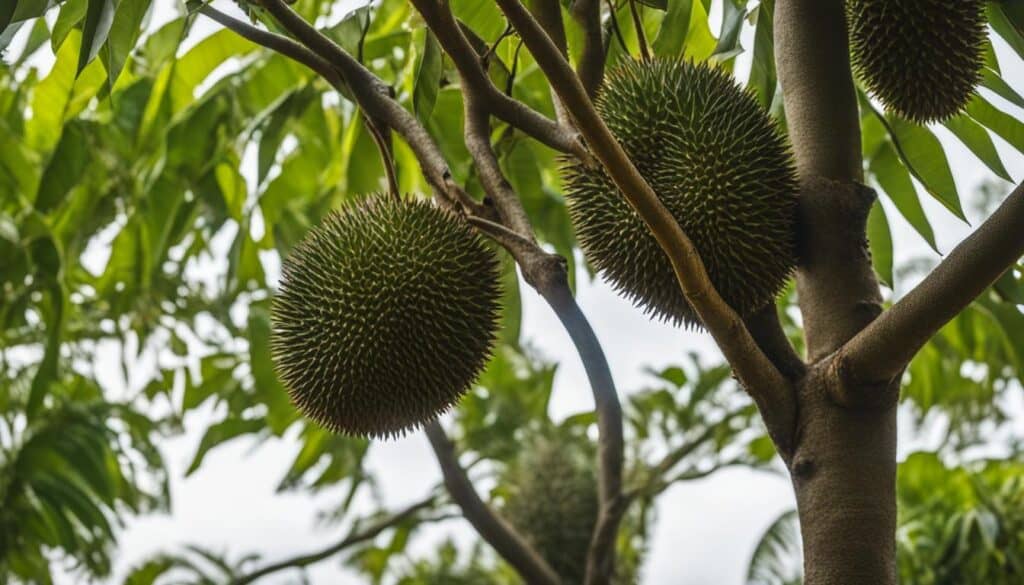
When it comes to durian tree care, regular maintenance is key to ensuring their long-term health and longevity. By implementing proper watering, fertilization, pruning, and pest control practices, you can help keep your durian trees healthy and productive.
Watering is essential for the well-being of durian trees, especially during dry periods. It is important to provide them with adequate moisture without overwatering, as excessive water can lead to root rot. Monitor the soil moisture regularly and adjust your watering schedule accordingly to maintain optimal hydration.
Another crucial aspect of durian tree care is fertilization. Durian trees benefit from regular feeding with a balanced fertilizer that provides essential nutrients. Apply the fertilizer according to the recommended dosage and frequency, considering the age and size of the trees. This will help promote healthy growth and enhance fruit production.
Pruning is an important practice to maintain the overall health and shape of durian trees. Regularly remove any dead, damaged, or diseased branches to minimize the risk of infections. Additionally, pruning helps improve airflow and light penetration, which is beneficial for the tree’s overall growth. Perform pruning during the dry season and avoid heavy pruning during the fruiting season to prevent stress on the tree.
Table: Durian Tree Care Tips
| Aspect | Recommendation |
|---|---|
| Watering | Provide adequate moisture without overwatering, especially during dry periods. |
| Fertilization | Regularly feed with a balanced fertilizer according to the recommended dosage and frequency. |
| Pruning | Remove dead, damaged, or diseased branches and promote better airflow and light penetration. |
| Pest Control | Implement organic pest control practices to protect the trees from common pests. |
Pest control is also crucial to prevent infestations and diseases that can harm durian trees. Implement organic pest control practices, such as using natural predators or organic insecticides, to protect the trees without harming the environment or compromising fruit quality. Regularly monitor the trees for signs of pests or diseases and take prompt action if any issues arise.
By following these durian tree care tips, you can maintain the health and longevity of your trees, ensuring they continue to thrive and produce delicious fruits for years to come.
Conclusion
In conclusion, the durian tree is a fascinating plant that captivates with its unique qualities. From its distinct fruits to its valuable timber, the durian tree holds a special place in the hearts of many. As we have explored throughout this article, caring for durian trees requires attention to detail and specific environmental conditions.
By providing adequate sunlight, well-drained soil, and regular watering, you can create an ideal environment for your durian tree to thrive. Proper pruning techniques help maintain its health and promote fruit production. Additionally, being mindful of pests and diseases and implementing appropriate control measures will safeguard your tree’s well-being.
Remember to choose the right durian tree variety that suits your preferences and growing conditions. Whether it’s the creamy Musang King or the fragrant D24, each variety offers its own delight. Take pleasure in the cultural significance and delectable flavors that durian trees bring to your garden.
FAQ
What is a durian tree?
A durian tree is a tropical fruit tree known for its exotic fruits and unique features. It is commonly found in Southeast Asia and southern China.
How tall can a durian tree grow?
Durian trees can reach impressive heights, with some varieties growing up to 150 feet tall. However, the height may vary depending on the specific variety and growing conditions.
How can I propagate a durian tree?
Durian trees can be propagated through seeds or grafting. Growing from seeds is more accessible for home gardeners, while grafting requires more expertise and involves joining a scion from a desired variety onto a rootstock.
When and how should I prune a durian tree?
Durian trees should be pruned during the dry season, and heavy pruning should be avoided during the fruiting season. Proper pruning techniques, such as making clean cuts and disinfecting tools, are essential to prevent the spread of diseases.
How do durian trees get pollinated?
Durian tree flowers are typically pollinated by bats or insects such as beetles and bees. Some varieties are self-fruitful, while others require cross-pollination with a compatible variety.
What are the environmental requirements for durian tree growth?
Durian trees thrive in tropical climates with high humidity and well-drained soil. They require full sunlight but can tolerate partial shade. Regular watering, fertilization, and pest control are also important.
How long does it take for a durian tree to produce fruits?
Durian trees typically take around 5-7 years to produce their first fruits.
What are some popular durian tree varieties?
Some popular durian tree cultivars include Musang King, D24, Monthong, and Chanee. Each variety differs in fruit size, shape, color, and taste.
What is the best way to care for durian trees?
Durian trees require regular watering, fertilization, pruning, and pest control. Adequate spacing, monitoring for diseases, and implementing organic pest control practices are also important for their health and productivity.
What are some fascinating facts about durian trees?
Durian trees are prized for their distinctive fruits and timber. The durian fruit has a strong odor and creamy flesh, earning it the nickname “the king of fruits.” Durian trees also hold deep cultural significance in Southeast Asian countries.
How can I ensure successful durian tree propagation?
Choosing high-quality seeds or grafts and providing the right conditions for germination or grafting is important for successful durian tree propagation.
How can I maintain the health and longevity of durian trees?
Regular maintenance and care, including watering, fertilization, pruning, and pest control, are essential for the long-term health and productivity of durian trees.



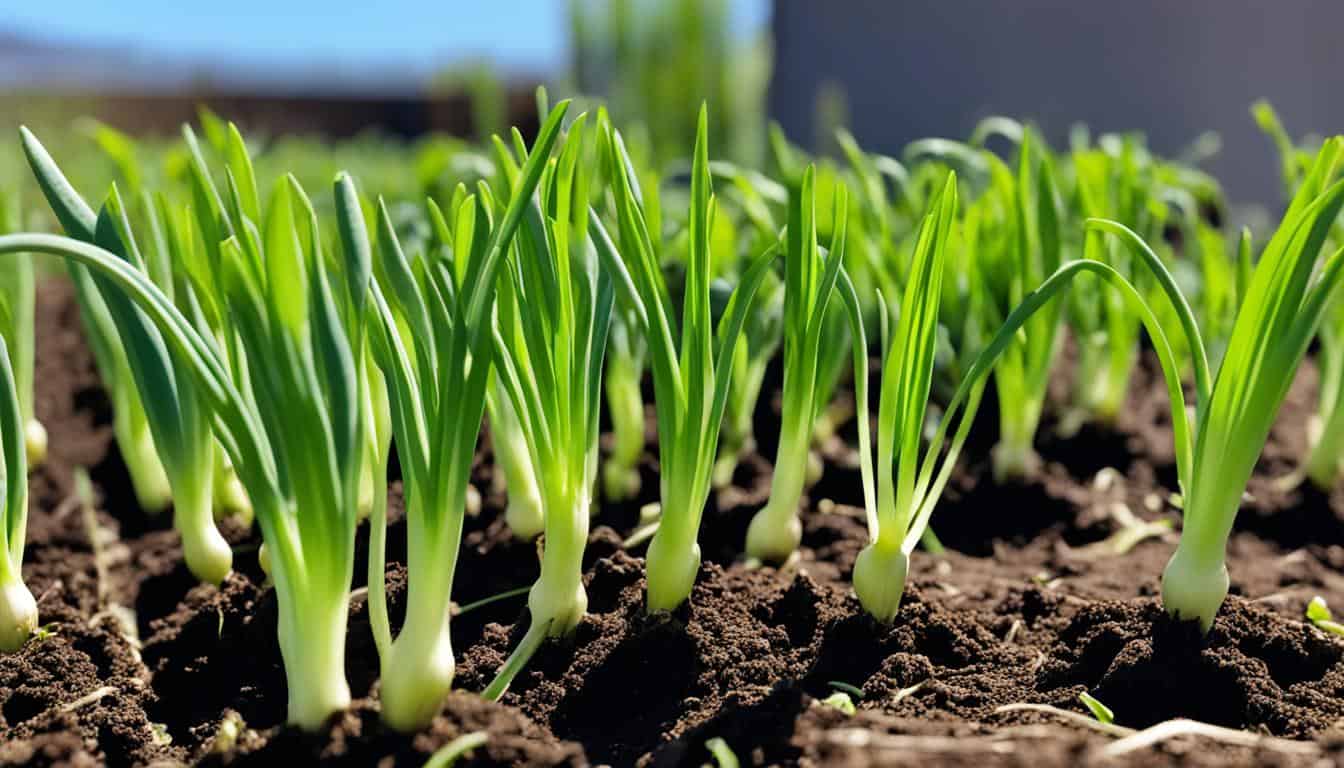
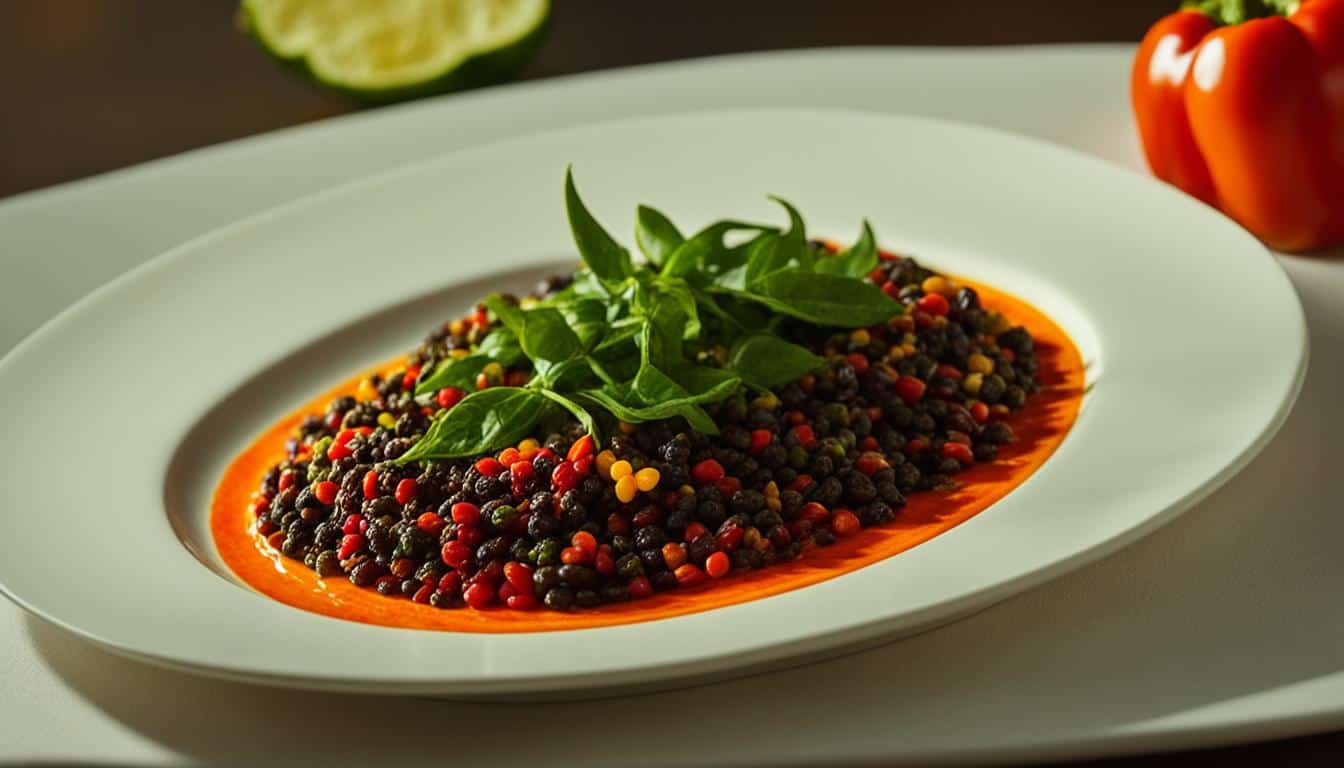
Leave a Reply